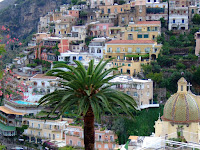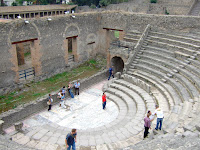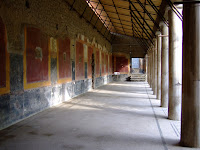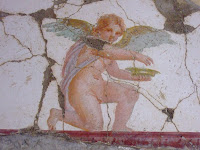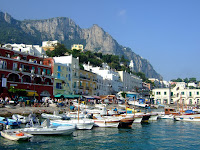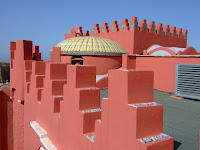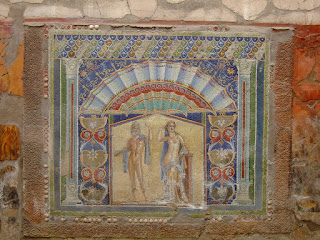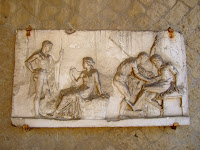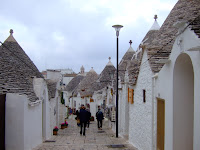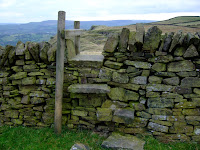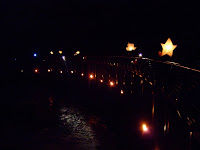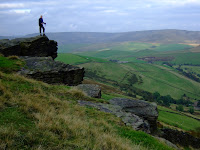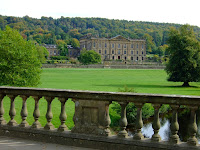
 From Greek Temples on the coast via a Carthusian Monastery to an Italian mountain eyrie along some very dodgy Italian back roads, the day was full of interest. Our day began at Paestum, originally a Grecian outpost from 700BC which was taken over by the Romans, then the malaria carrying mosquitoes, which got rid of the people;
From Greek Temples on the coast via a Carthusian Monastery to an Italian mountain eyrie along some very dodgy Italian back roads, the day was full of interest. Our day began at Paestum, originally a Grecian outpost from 700BC which was taken over by the Romans, then the malaria carrying mosquitoes, which got rid of the people; 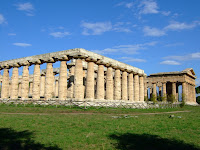 and finally by the jungle where it remained hidden until a funny thing happened on the way to the forum in the 18th Century when a road builder drove a bulldozer (as it were) though the arena and rediscovered the site. Today the Greek temples are some of the finest examples outside of Greece and are simply stunning.
and finally by the jungle where it remained hidden until a funny thing happened on the way to the forum in the 18th Century when a road builder drove a bulldozer (as it were) though the arena and rediscovered the site. Today the Greek temples are some of the finest examples outside of Greece and are simply stunning. After a good look around the site and the accompanying museum, where there is exhibited a unique painted tomb with a diver symbolizing the plunge from the end of the known world into the unknown, we set off into the unknown across some mountains looking for Padula, to find the St Lawrence Carthusian Monastery we were seeking.
After a good look around the site and the accompanying museum, where there is exhibited a unique painted tomb with a diver symbolizing the plunge from the end of the known world into the unknown, we set off into the unknown across some mountains looking for Padula, to find the St Lawrence Carthusian Monastery we were seeking. It is unbelievable that this huge complex was there to service the spiritual needs of just 24 Carthusian Monks. The interiors were remodelled in the Baroque period using inlaid marble, mother of pearl, gold leaf and so forth.
It is unbelievable that this huge complex was there to service the spiritual needs of just 24 Carthusian Monks. The interiors were remodelled in the Baroque period using inlaid marble, mother of pearl, gold leaf and so forth. 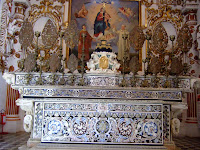 Behind the monks seats in the chapel are inlaid wood scenes for the life of Christ and in front of their pews the wood inlay pictures depict the martyrdom of various saints. After the (Italian) dissolution of the monasteries it has been a children's camp, a WWI concentration camp and various other roles before being recently rescued and restored as a tourist attraction that is clearly not expecting anyone other than Italian tourists. The maoastery has the largest cloister in the world enclosing nearly 3 acres.
Behind the monks seats in the chapel are inlaid wood scenes for the life of Christ and in front of their pews the wood inlay pictures depict the martyrdom of various saints. After the (Italian) dissolution of the monasteries it has been a children's camp, a WWI concentration camp and various other roles before being recently rescued and restored as a tourist attraction that is clearly not expecting anyone other than Italian tourists. The maoastery has the largest cloister in the world enclosing nearly 3 acres.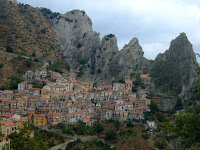 Back in the car we finally convinced the sat-nav to take us to our final destination via a sensible route but even so the contrast between crow-flies distance and road distance was surprising. Eventually, after crossing another pass at 1145m, and in the clouds, we descended into Castelmezzano, a magical place clinging to the mountainside among majestic dolomite peaks.
Back in the car we finally convinced the sat-nav to take us to our final destination via a sensible route but even so the contrast between crow-flies distance and road distance was surprising. Eventually, after crossing another pass at 1145m, and in the clouds, we descended into Castelmezzano, a magical place clinging to the mountainside among majestic dolomite peaks.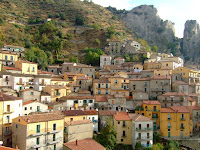 This town is rather off the normal tourist route, but we found fabulous accommodation at the La Locanda di Castomediano. Our hostess, Antonia, indicated that we were the first New Zealanders to stay there. The three highlights of the day were very different, but we would recommend them all to anyone visiting this part of Italy.
This town is rather off the normal tourist route, but we found fabulous accommodation at the La Locanda di Castomediano. Our hostess, Antonia, indicated that we were the first New Zealanders to stay there. The three highlights of the day were very different, but we would recommend them all to anyone visiting this part of Italy.We left the choice of our evening menu in the capable hands of Antonia, who did us proud with a mushroom salad antipasto, two delicious pastas and a rolled beef second platti; all local dishes which we enjoyed with a bottle of local red wine. The wine list here is amazing: 4 whites; 2 rose; 2 pages of Basilicata reds; possibly 6 pages of other Italian reds; and one page of reds of the world.

